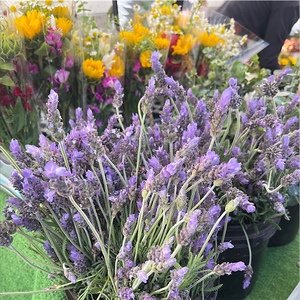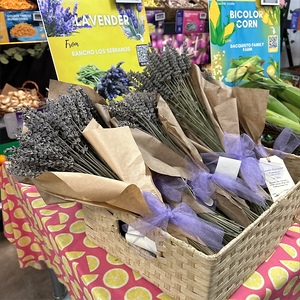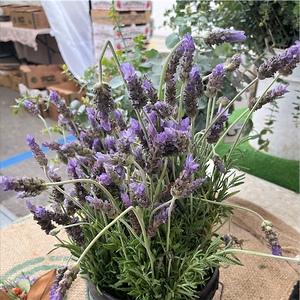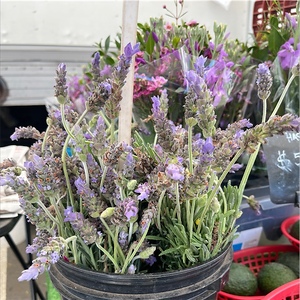


Lavender
Estimated Inventory, lb : 2.97
This item was last sold on : 04/18/25
Description/Taste
Lavender varies in size, shape, and overall appearance, depending on the specific species. All Lavender species generally have an upright, short, bushy, shrub-like appearance, and the plants are typically evergreen to semi-evergreen. The plants produce tough woody branches that develop soft, silver-green to grey-green leaves found in oblong, lanceolate, tapered, or needle-like shapes. Some Lavender leaves may be covered in a velvety downy fuzz, while others may be smoother with a pliable feel. They can also have even edges or be noticeably toothed. Seasonal flowers appear on long pale green stems, and the blooms are often spirally arranged. Lavender flowers appear in shades of pink, blue-purple, purple, violet, and variegated hues of white and pink. Some species may also have a cylindrical, pineapple-like shape with bracts arising from the top, while other flowers are small and delicate. Lavender flowers are smooth, soft, and fragrant. The plant’s aroma is created from oil glands that release essential oils from the stems, leaves, and flowers. This scent is often detected when the plants are brushed against or slightly crushed. Lavender has a sweet, floral, subtly fruity, herbal, and earthy scent, varying with each variety. Lavender flowers and leaves can be incorporated into culinary preparations in small quantities and have a strong, floral, and faintly sweet taste with mint, rosemary, and citrus nuances.
Seasons/Availability
Lavender grown in open fields is generally harvested in the spring and early summer. In some climates, Lavender can be grown year-round.
Current Facts
Lavender, botanically a part of the Lavandula genus, is a category of multiple plant species belonging to the Lamiaceae family. All fragrant, flowering shrubs under the Lavender name are classified in the Lavandula genus, and each species is favored for ornamental, culinary, or medicinal uses. There are around 45 species within Lavandula that contain many different varieties appearing in varying shades, shapes, and colors, and the most popular species include English, French, Lavandin, Spanish, and Portuguese types. The most well-known Lavender species is Lavandula angustifolia or Lavandula officinalis, sometimes called English lavender, True lavender, and Common lavender. English lavender is the species used for culinary purposes and essential oils, and experts believe there are currently over 100 varieties within the species. English lavender is also considered the species with the best flavor as it contains a lower camphor content, an oil that gives lavender a bitter, soapy, or medicinal taste. Lavandula dentata, or French lavender, and Lavandula x intermedia, named Lavandin, are sometimes used for culinary purposes but are much rarer. Spanish lavender, Lavandula stoechas, and Portuguese Lavender, Lavandula latifolia, are reserved for ornamental uses in home gardens and urban landscapes. Lavender, in general, has been used for centuries in culinary and medicinal practices and is treasured for its fragrant aroma and sweet, floral taste in a wide array of sweet or savory preparations.
Nutritional Value
Lavender is revered for its use in aromatherapy and medicinal practices. Historically, Lavender flowers have been used to soothe headaches and reduce anxiety. The fresh or dried blooms are inhaled and are believed to have sedative effects. Compounds in the scent of the flowers are also thought to have antibacterial, antiseptic, and antifungal properties. The name Lavender is derived from the Latin name Lavandula, which comes from the word “lavare,” meaning “to wash.” This name is rumored to have been given by the Romans as Lavender was a popular fragrance for scenting Roman baths. Lavender also has some iron, vitamin A, and calcium, but it is unlikely the flowers will be consumed in the amounts needed to impact nutrition in daily diet. Lavender should never be consumed in excessive quantities.
Applications
Lavender has a fragrant, floral, and sweet taste suited for fresh and cooked culinary preparations. Only certain species of Lavender should be utilized in culinary preparations, and most culinary Lavenders fall under the species Lavandula angustifolia. Culinary lavender is utilized as a flavoring agent to add depth to dishes. Fresh or dried flowers can be served beside desserts, ice cream, or sorbet as a garnish or mixed into marinades, sauces, mustards, and honey. Chop the flowers and mix them into soft cheeses, fold them into buttercream for a floral scent, or combine them into butter. Lavender flowers can also be chopped and sprinkled into sugar for use in cookies, shortbreads, cakes, and scones. The robust fragrance of Lavender is simmered into syrups, jams, and jellies, and the flowers are cooked into savory sauces for stews and roasted meats. The flowers are also infused into apple sauce or tossed into potato dishes. Lavender helps to cut rich foods, and a browned butter sauce is used to pour over roasted vegetables. Sprigs of Lavender leaves and flowers are also rubbed over meats, stirred into cocktails, or thrown on barbeques to infuse a floral and herbal smoked flavor into dishes. Lavender pairs well with herbs such as rosemary, oregano, sage, and thyme, fruits including lemon, strawberries, pears, and blueberries, and meats such as turkey, lamb, poultry, and beef. Fresh Lavender will last ten days in a cool, dry, dark place with ample air circulation. The flowers are most popularly dried as they can be stored for extended periods. Dried Lavender should be stored in an airtight container for up to one year.
Ethnic/Cultural Info
Lavender is deeply intertwined with many European tales, legends, and myths. During the 15th and 16th centuries, young women would drink Lavender tea in hopes of dreaming about their true love. Lavender flowers would also be placed into pillowcases to improve sleep and encourage romantic thoughts. Lavender has remained a famous fragrance throughout history and has been worn by the nobility and common classes. One of the most famous legends dates to 15th century France. Legend has it that a group of thieves would cover themselves in an herbal mixture, including the scent of Lavender, to ward off the bubonic plague. The thieves would wear the oil on their skin and clothing to loot dead bodies that had perished from the plague. There are several versions of this story, but in a nutshell, the tale propelled this herbal oil mixture into natural medicines as a scent to ward off disease. The mixture is now known as the Four Thieves Vinegar and is typically made up of a combination of Lavender, thyme, sage, rosemary, mint, rue, wormwood, or garlic.
Geography/History
Lavender is believed to be native to regions of the Mediterranean and possibly parts of India and the Middle East. The flowering shrubs have been growing wild since ancient times and thrive in sunny climates with cool winters and hot summers. Lavender was used in Ancient Egypt as a perfume, especially during the mummification process for pharaohs. The flowers and leaves were also used to scent baths throughout the Ancient Roman and Greek empires, naturally spreading with migrating people and merchants along trade routes throughout Europe and Asia. Over time, many species of Lavender were discovered and cultivated, and Lavender was recorded to have reached England sometime in the 16th century. Queen Elizabeth later contributed to the plant’s popularity as she is said to have worn it as a perfume and used it as a scent for household cleaners. Lavender was quickly planted throughout Europe and was utilized for ornamental, medicinal, and culinary purposes. Various species were also introduced to the New World and were planted in North America. Today, Lavender is grown worldwide, and there are many different species with individual histories. Lavender flowers and sprigs are sold fresh or dried through farmer’s markets, specialty retailers, and distributors.
Featured Restaurants
Restaurants currently purchasing this product as an ingredient for their menu.
| Gelato 101 (Solana) | Solana Beach CA | 858-404-0799 |
| Sago (Bar) | Encinitas CA | 858-382-4047 |
| Nolita Hall - Bar | San Diego CA | 619-618-8820 |
| Great Maple Hillcrest | San Diego CA | 619-255-2282 |
| JRDN Restaurant | San Diego CA | 858-270-5736 |
| Park Hyatt Aviara (Ember & Rye) | Carlsbad CA | 760-448-1234 |
| South O Brewing Catering | Oceanside CA | 925-381-5392 |
| Books and Records | San Diego CA | 619-310-5298 |
| Bica | San Diego CA | 619-669-5725 |
| Herb & Wood Bar | San Diego CA | 619-955-8495 |
| Trust Restaurant (Bar) | San Diego CA | 609-780-7572 |
| Dot Cafe | San Diego CA | 914-263-1424 |
Recipe Ideas
Recipes that include Lavender. One

















